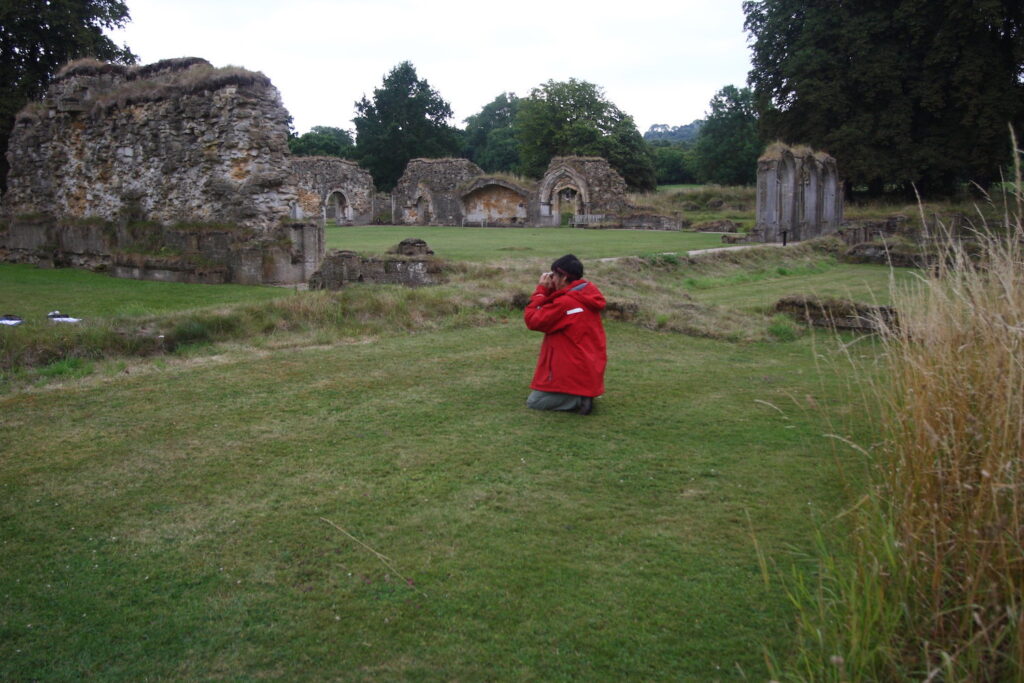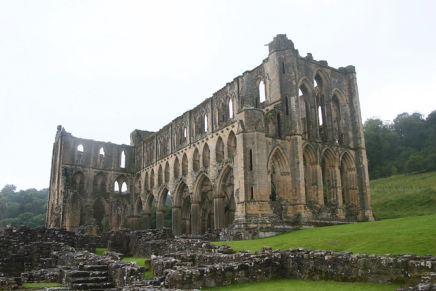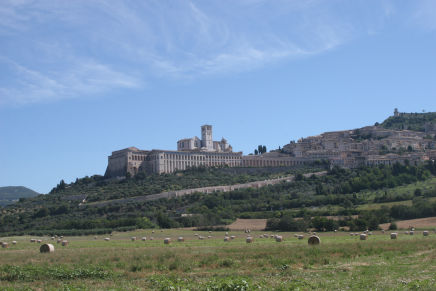Research
My research interests lie in the exploration of frescoes in medieval Italy, in the orientation of Cistercian abbey churches in Wales, UK, and Europe and their theological relationship to landscape, as well as how, in contemporary western astrology, meaning is derived from natal horoscopes.
Key links
Skyscapes
Welsh Monastic Skyscapes Project
University of Wales Trinity Saint David, The Sophia Centre.
Publication: Brady, Bernadette, Darrelyn Gunzburg, and Fabio Silva. ‘The Orientation of Cistercian Churches in Wales: A Cultural Astronomy Case Study.’ Cîteaux – Commentarii cistercienses 67, no. 3-4 (2016): 275-302.
This paper considers how the union of sun, landscape, and architecture contributes to the understanding of Welsh Cistercian Abbeys. From August 2014 to March 2016 we surveyed and measured the orientation of all Cistercian monastic sites with extant foundations in Wales, as well as the elevation of their surrounding landscapes. Subsequent analysis of this data using methodologies drawn from cultural astronomy revealed that, by intentionally orientating the abbey to make use of the local topography, each Welsh Cistercian abbey church formed a relationship to the sun’s light on theologically significant days. Other themes that emerged include the emphasis on sunsets and the west; the focus on the astronomical equinox rather than that of the Julian calendar equinox; and the solar position on Michaelmas and/or Saint David’s Day. We conclude by discussing the implications of these results for wider debates in the field of Cistercian studies.

The Cistercian Skyscapes Project
Publication: Brady, Bernadette, Darrelyn Gunzburg, and Fabio Silva. ‘The Sun’s Light at Michaelmas and the Cistercians of Britain and Ireland.’ Cîteaux – Commentarii cistercienses 72, no. 1-4 (2021): 47-65.
This paper builds on research that was carried out between August 2014 and March 2016 when our team set out to investigate the sun’s role in the churches of the eleven extant Cistercian Abbeys in Wales, all of which are now in ruins—Basingwerk, Margam, Cwmhir, Cymer, Neath, Strata Florida, Llanllugan, Valle Crucis, Aberconwy 1, Whitland, and Tintern. The results of Stage 1 left open the question as to whether the orientation of Welsh Cistercian abbey churches to Michaelmas and/or Saint David’s Day was specific to Wales or was instead part of a wider story that involved Cistercian abbey churches in England, Scotland, and the island of Ireland.1 This paper completes that research. It first recaps the methodology we used when measuring the Welsh Cistercian abbey churches which involved understanding how the sun moves in the sky across the year; outlining how we measured the orientation of the abbey churches; looking at how we considered them in their unique horizon views; and finally engaging with how they received the sun’s light on key Julian calendar dates. We then present our findings from the second stage of our fieldwork in measuring the English and Scottish abbey churches, as well as those on the island of Ireland.

Reflecting on Mary: The Splendor of the Madonna in the Lower Church of Assisi.
Publication: Gunzburg, Darrelyn. ‘Reflecting on Mary: the Splendor of the Madonna in the Lower Church of Assisi.’ In Mater Sanctissima, Misericordia, Et Dolorosa: Medieval Franciscan Approaches to the Virgin Mary, edited by Steven J. McMichael. Franciscan Tradition in the Middle Ages. Leiden: Brill, 2019.
The Basilica of San Francesco, the place that was created as the burial site of St. Francis of Assisi (c.1181/82-1226), the founder and leader of the Friars Minor, consists of two churches one on top of the other, both cruciform in plan with a single nave. As has been well-documented, the Lower Church was dug into the rock and completed on 25 May 1230, when St. Francis’ body was translated from the Church of St. George, where it had been taken and buried on his death to avoid being ransacked by the Perugians. Thus the Lower Church served as a sanctuary for the tomb of St. Francis. This Lower Church is a place into which little natural daylight falls. Nevertheless, in the reconstruction and redecoration that occurred from 1288 onwards, two frescos of Mary were painted in the second decade of the fourteenth century in the north and south transepts, both with gilded backgrounds. La Madonna dei Tramonti (Madonna of the Sunsets) was painted by Pietro Lorenzetti (c.1280–c.1348) between the years 1316–1319, located towards the base of the east wall of the south transept. The name was said to derive from the fact that every evening the fresco is lit by the rays of the setting sun. Yet the literature on this fresco is not clear with regards to which sunsets the title is referring, why the sunlight was considered theologically important, nor how sunlight could get into the lower church. A second fresco, the Madonna and Child with Two Royal Saints, painted by Simone Martini (1284-1344) slightly earlier than those of Lorenzetti, is situated in mirror position to La Madonna dei Tramonti, on the opposite side of the crossing towards the base of the east wall of the north transept. The literature is silent about the connection of this fresco in relation to the sun. This paper, therefore, considers both frescos from the perspectives of their initial creation, their subject matter, their placements in connection with the sun, and the associated role of the sun in Christian theology as a way of investigating how the medieval Franciscans understood and reflected on Mary.

Space, Place and Religious Landscapes
Gunzburg, Darrelyn, and Bernadette Brady, eds. Space, Place, and Religious Landscapes: Living Mountains. London: Bloomsbury Academic, 2020.
Exploring sacred mountains around the world, this book examines whether bonding and reverence to a mountain is intrinsic to the mountain, constructed by people, or a mutual encounter. Chapters explore mountains in England, Scotland, Wales, Italy, Ireland, the Himalaya, Japan, Greece, USA, Asia and the Andes, and embrace the union of sky, landscape and people to examine the religious dynamics between human and non-human entities.
This book takes as its starting point the fact that mountains physically mediate between land and sky and act as metaphors for bridges from one realm to another, recognising that mountains are relational and that landscapes form personal and group cosmologies. The book fuses ideas of space, place and material religion with cultural environmentalism and takes an interconnected approach to material religio-landscapes. In this way it fills the gap between lived religious traditions, personal reflection, phenomenology, historical context, environmental philosophy, myths and performativity.
In defining material religion as active engagement with mountain-forming and human- shaping landscapes, the research and ideas presented here provide theories that are widely applicable to other forms of material religion.

PhDHistory of Art, University of Bristol, Faculty of Arts, School of Humanities, Department of Historical Studies. |
Thesis: Giotto’s Salone: An astrological investigation into the fresco paintings of the first floor |
SOME PUBLISHED ARTICLES
| · Make and Create: The Caftswomen in the Salone Freoes of the Palazzo Della Ragione, Padua’ in Medieval Clothing and Textiles.18: 99-128, edited by Cordelia Warr. Martlesham: Boydell & Brewer Ltd. |
· ‘The Sun’s Light at Michaelmas and the Cistercians of Britain and Ireland.’ Cîteaux – Commentarii cistercienses 72, no. 1-4: 47-65. Co-authored with B. Brady and F. Silva.
|
· ‘The Summer Triangle and the Stymphalian Birds.’ Culture and Cosmos: The Talking Sky 24, no. 1 and 2: 37-53. |
· ‘Time Pursued by a Bear: Ursa Major and Stellar Time-Telling in the Paduan Salone.’ In Visualising Skyscapes: Material Forms of Cultural Engagement with the Heavens, edited by Liz Henty and Daniel Brown, 158-176. London and New York: Routledge.
|
· ‘Reflecting on Mary: the Splendor of the Madonna in the Lower Church of Assisi.’ In Medieval Franciscan Approaches to the Virgin Mary: Mater Sanctissima, Misericordia, Et Dolorosa, edited by Steven J. McMichael and Katie Wrisly Shelby. The Medieval Franciscans, 302-334. Leiden; Boston: Brill.
|
· ‘The Horoscopic Place: The Encounter between Astrologer and Client.’ Journal for the Study of Religion, Nature & Culture 13, no. 1 (2019): 44-60.
|
· ‘Al-Qabisi.’ In Astrology through History: Interpreting the Stars from Ancient Mesopotamia to the Present, edited by William E. Burns, 17-19. Santa Barbara: ABC-CLIO. |
· ‘Medieval European Astrology.’ In Astrology through History: Interpreting the Stars from Ancient Mesopotamia to the Present, edited by William E. Burns, 218-222. Santa Barbara: ABC-CLIO.
|
|
· ‘Art.’ In Astrology through History: Interpreting the Stars from Ancient Mesopotamia to the Present, edited by William E. Burns, 27-33. Santa Barbara: ABC-CLIO.
|
· ‘The Orientation of Cistercian Churches in Wales: A Cultural Astronomy Case Study.’ Cîteaux – Commentarii cistercienses 67, no. 3-4 (2016): 275-302. Co-authored with B. Brady and F. Silva.
|
· ‘Giotto’s Sky: The Fresco Paintings of the First Floor Salone of the Palazzo Della Ragione, Padua, Italy.’ In The Imagined Sky: Cultural Perspectives, edited by Darrelyn Gunzburg. 87-113. Sheffield: Equinox Publishing.
|
· ‘Giotto’s Sky: The fresco paintings of the first floor Salone of the Palazzo della Ragione, Padua, Italy.’ Journal for the Study of Religion, Nature and Culture 7, no. 4 (2013): 407-433.
|
· ‘The Perugia Fountain: An Encyclopaedia of Sky, Culture and Society’. In Sky and Symbol, edited by Nicholas Campion and Liz Greene, 103-118. Ceredigion: Sophia Centre Press, University of Wales Trinity Saint David.
|
· ‘How Do Astrologers Read Charts?’ In Astrologies: Plurality and Diversity, edited by Nicholas Campion and Liz Greene, 181-200. Ceredigion: Sophia Centre Press, University of Wales, Trinity Saint David.
|
· ‘Looking Back: The Transgression of Social Codes Explored through the Direct Gaze in Fra Angelico’s San Marco Altarpiece When Compared with Madonna and Child with Eight Saints’. St Andrews Journal of Art History and Museum Studies 14 (2010), 31-44. |
Get in touch
If you would like to speak to me about any of the publications or work on this website please send me a message using the form below.
You can also contact me on Facebook.
Enquiry form

Darrelyn Gunzburg at the ‘Sensing Spaces, Architecture reimagined’ exhibition at the Royal Academy, London, UK, 2014.